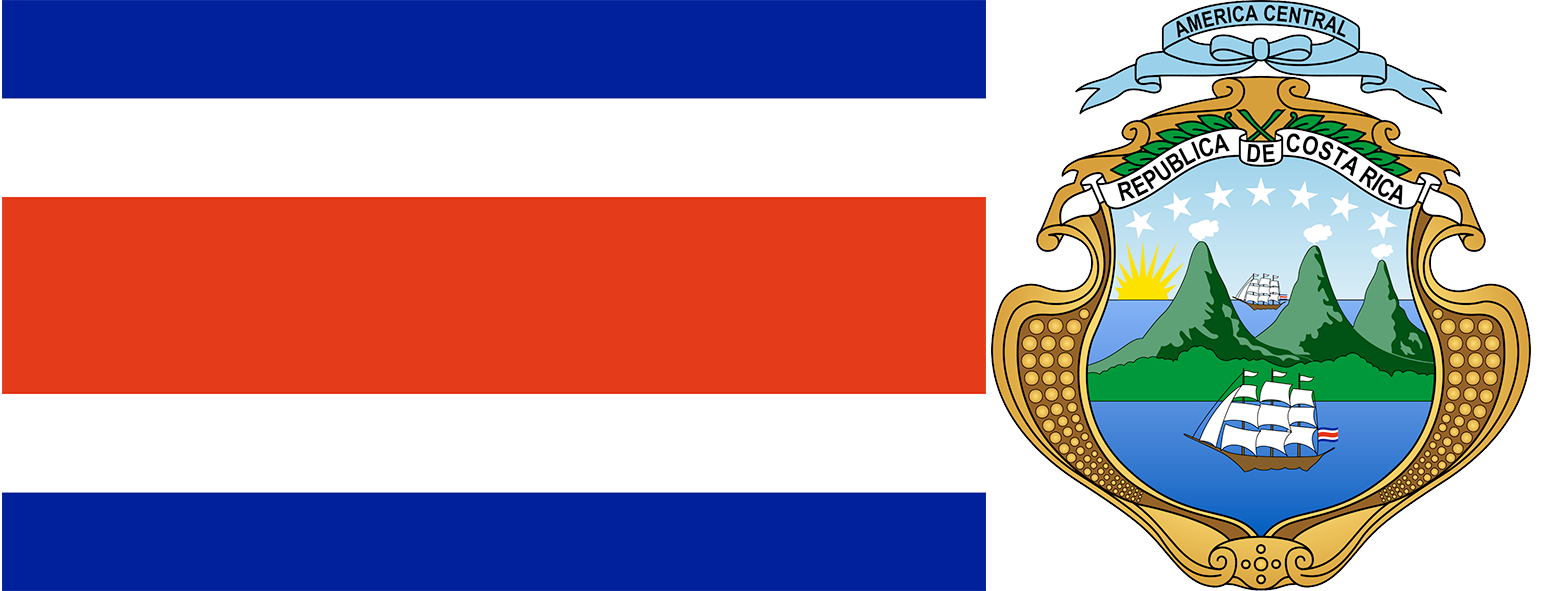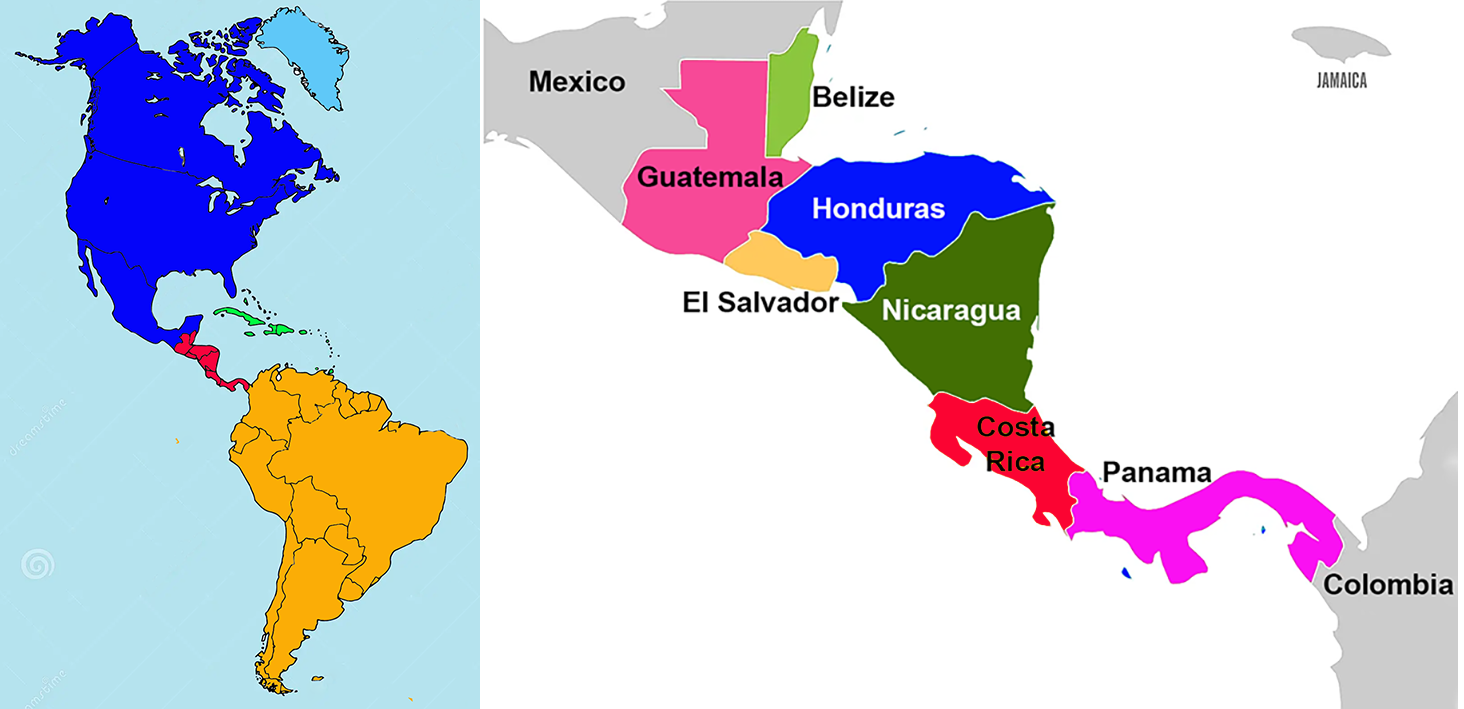FabulousFusionFood's Costa Rican Recipes Home Page
 The flag of Costa Rica (left) and the coat of arms of Costa Rica (right).
The flag of Costa Rica (left) and the coat of arms of Costa Rica (right).
Welcome to the summary page for FabulousFusionFood's Costa Rican recipes, part of South America. This page provides links to all the Costa Rican recipes presented on this site, with 4 recipes in total.
This is a continuation of an entire series of pages that will, I hope, allow my visitors to better navigate this site. As well as displaying recipes by name, country and region of origin I am now planning a whole series of pages where recipes can be located by meal type and main ingredient. This page gives a listing of all the Costa Rican recipes added to this site.
Costa Rica, (República de Costa Rica in Spanish), officially the Republic of Costa Rica, is a country in Central America. It borders Nicaragua to the north, the Caribbean Sea to the northeast, Panama to the southeast, and the Pacific Ocean to the southwest. Spanish is the official language and Mekatelyu, Bribri, and Patois are recognised regional languages. San José is the capital and largest city.
Costa Rican cuisine is a blend of Native American, Spanish, African, and many other cuisines origins. Dishes such as the very traditional tamale and many others made of corn are the most representative of its indigenous inhabitants, and similar to other neighbouring Mesoamerican countries. Spaniards brought many new ingredients to the country from other lands, especially spices and domestic animals. Later in the 19th century, the African flavour lent its presence with influence from other Caribbean mixed flavours.
Costa Rica, officially the Republic of Costa Rica, is a country in Central America. It borders Nicaragua to the north, the Caribbean Sea to the northeast, Panama to the southeast, and the Pacific Ocean to the southwest, as well as maritime border with Ecuador to the south of Cocos Island. It has a population of around five million in a land area of nearly 51,180 km2. An estimated 352,381 people live in the capital and largest city, San José, with around two million people in the surrounding metropolitan area.
 Location of Costa Rica in Central America with the land mass of Costa Rica
Location of Costa Rica in Central America with the land mass of Costa Rica
picked out in red.The sovereign state is a presidential republic. It has a long-standing and stable constitutional democracy and a highly educated workforce. The country spends roughly 6.9% of its budget (2016) on education, compared to a global average of 4.4%. Its economy, once heavily dependent on agriculture, has diversified to include sectors such as finance, corporate services for foreign companies, pharmaceuticals, and ecotourism. Many foreign manufacturing and services companies operate in Costa Rica's Free Trade Zones where they benefit from investment and tax incentives.
Costa Rica was inhabited by indigenous peoples before coming under Spanish rule in the 16th century. It remained a peripheral colony of the empire until independence as part of the First Mexican Empire, followed by membership in the Federal Republic of Central America, from which it formally declared independence in 1847. Following the brief Costa Rican Civil War in 1948, it permanently abolished its army in 1949, becoming one of only a few sovereign nations without a standing army
The country has consistently performed favourably in the Human Development Index (HDI), placing 58th in the world as of 2022, and fifth in Latin America. It has also been cited by the United Nations Development Programme (UNDP) as having attained much higher human development than other countries at the same income levels, with a better record on human development and inequality than the median of the region. It performs well in comparisons of democratic governance, press freedom, subjective happiness and sustainable wellbeing. It has the 26th freest press according to the 2024 Press Freedom Index, it is the 35th most democratic country according to the 2021 Freedom in the World index, and it is the 23rd happiest country in the 2023 World Happiness Report. It is also a major tourist destination in the continent.
Etymology: The name 'Costa Rica' translates to 'Rich Coast' in Spanish. It was given by Christopher Columbus during his exploration in 1502, reflecting the lush resources and potential wealth of the region. The term was used to describe the coastal areas of the country, which were rich in natural resources. The name has persisted through the centuries, becoming the official name of the country.
Costa Rican cuisine is known for being mostly mild, with high reliance on fruits and vegetables. Rice and black beans are a staple of most traditional Costa Rican meals, often served three times a day. Costa Rican fare is nutritionally well rounded, and nearly always cooked from scratch from fresh ingredients. Owing to the location of the country, tropical fruits and vegetables are readily available and included in the local cuisine.
This is a continuation of an entire series of pages that will, I hope, allow my visitors to better navigate this site. As well as displaying recipes by name, country and region of origin I am now planning a whole series of pages where recipes can be located by meal type and main ingredient. This page gives a listing of all the Costa Rican recipes added to this site.
Costa Rica, (República de Costa Rica in Spanish), officially the Republic of Costa Rica, is a country in Central America. It borders Nicaragua to the north, the Caribbean Sea to the northeast, Panama to the southeast, and the Pacific Ocean to the southwest. Spanish is the official language and Mekatelyu, Bribri, and Patois are recognised regional languages. San José is the capital and largest city.
Costa Rican cuisine is a blend of Native American, Spanish, African, and many other cuisines origins. Dishes such as the very traditional tamale and many others made of corn are the most representative of its indigenous inhabitants, and similar to other neighbouring Mesoamerican countries. Spaniards brought many new ingredients to the country from other lands, especially spices and domestic animals. Later in the 19th century, the African flavour lent its presence with influence from other Caribbean mixed flavours.
Costa Rica, officially the Republic of Costa Rica, is a country in Central America. It borders Nicaragua to the north, the Caribbean Sea to the northeast, Panama to the southeast, and the Pacific Ocean to the southwest, as well as maritime border with Ecuador to the south of Cocos Island. It has a population of around five million in a land area of nearly 51,180 km2. An estimated 352,381 people live in the capital and largest city, San José, with around two million people in the surrounding metropolitan area.
 Location of Costa Rica in Central America with the land mass of Costa Rica
Location of Costa Rica in Central America with the land mass of Costa Ricapicked out in red.
Costa Rica was inhabited by indigenous peoples before coming under Spanish rule in the 16th century. It remained a peripheral colony of the empire until independence as part of the First Mexican Empire, followed by membership in the Federal Republic of Central America, from which it formally declared independence in 1847. Following the brief Costa Rican Civil War in 1948, it permanently abolished its army in 1949, becoming one of only a few sovereign nations without a standing army
The country has consistently performed favourably in the Human Development Index (HDI), placing 58th in the world as of 2022, and fifth in Latin America. It has also been cited by the United Nations Development Programme (UNDP) as having attained much higher human development than other countries at the same income levels, with a better record on human development and inequality than the median of the region. It performs well in comparisons of democratic governance, press freedom, subjective happiness and sustainable wellbeing. It has the 26th freest press according to the 2024 Press Freedom Index, it is the 35th most democratic country according to the 2021 Freedom in the World index, and it is the 23rd happiest country in the 2023 World Happiness Report. It is also a major tourist destination in the continent.
Etymology: The name 'Costa Rica' translates to 'Rich Coast' in Spanish. It was given by Christopher Columbus during his exploration in 1502, reflecting the lush resources and potential wealth of the region. The term was used to describe the coastal areas of the country, which were rich in natural resources. The name has persisted through the centuries, becoming the official name of the country.
Costa Rican Cuisine:
Costa Rican cuisine is a blend of Native American, Spanish, African, and many other cuisines origins. Dishes such as the very traditional tamale and many others made of corn are the most representative of its indigenous inhabitants, and similar to other neighbouring Mesoamerican countries. Spaniards brought many new ingredients to the country from other lands, especially spices and domestic animals. Later in the 19th century, the African flavour lent its presence with influence from other Caribbean mixed flavours.Costa Rican cuisine is known for being mostly mild, with high reliance on fruits and vegetables. Rice and black beans are a staple of most traditional Costa Rican meals, often served three times a day. Costa Rican fare is nutritionally well rounded, and nearly always cooked from scratch from fresh ingredients. Owing to the location of the country, tropical fruits and vegetables are readily available and included in the local cuisine.
The alphabetical list of all the Costa Rican recipes on this site follows, (limited to 100 recipes per page). There are 4 recipes in total:
Page 1 of 1
| Baked Tilapia with Pineapple and Black Beans Origin: Costa Rica | Hervido de pescado (Boiled Fish with Vegetables) Origin: Costa Rica |
| Crockpot Costa Rican Beef and Vegetable Soup with Yellow Rice Origin: Costa Rica | Huevos Rancheros Origin: Costa Rica |
Page 1 of 1